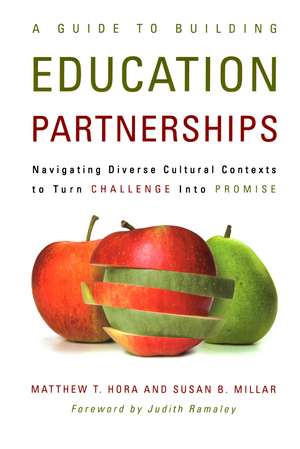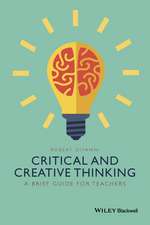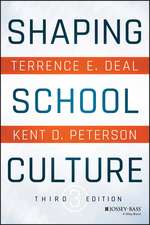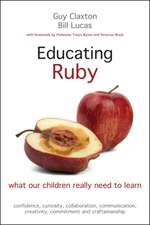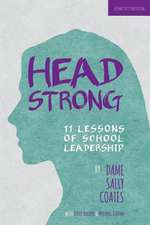A Guide to Building Education Partnerships: Navigating Diverse Cultural Contexts to Turn Challenge into Promise
Autor Matthew T. Hora, Susan B. Millaren Limba Engleză Paperback – 24 ian 2011
Preț: 245.94 lei
Nou
Puncte Express: 369
Preț estimativ în valută:
47.07€ • 48.96$ • 38.86£
47.07€ • 48.96$ • 38.86£
Carte tipărită la comandă
Livrare economică 15-29 aprilie
Preluare comenzi: 021 569.72.76
Specificații
ISBN-13: 9781579224721
ISBN-10: 1579224725
Pagini: 230
Dimensiuni: 152 x 229 x 15 mm
Greutate: 0.33 kg
Ediția:1
Editura: Taylor & Francis
Colecția Routledge
Locul publicării:Oxford, United Kingdom
ISBN-10: 1579224725
Pagini: 230
Dimensiuni: 152 x 229 x 15 mm
Greutate: 0.33 kg
Ediția:1
Editura: Taylor & Francis
Colecția Routledge
Locul publicării:Oxford, United Kingdom
Public țintă
Postgraduate and Professional Practice & DevelopmentCuprins
Introduction. The Challenge and Promise of Education Partnerships The Nature of Education Partnerships Working in a Partnership. New Tasks and Challenges Methodology. Understanding the Underlying Mechanisms of Partnership The Five Principles of Partnership How To Use This Book Part One. Getting Ready for Partnership 1 Shall We Dance? Convening a Pre-Partnership Planning Group Convening a Pre-Partnership Planning Group A Final Word on Pre-Partnership Planning 2 Sizing Up Organizational Aspirations and Attributes Problems, Goals, and Objectives Motivations Capacity and Resources Autonomy and Interdependence 3 Understanding Cultural Dynamics Avoiding the Common-Culture Myth Focusing On Cultural Dynamics Within Organizations Agenda Items for Your Pre-Partnership Meeting 4 Crossing Organizational and Cultural Boundaries Why Boundary Crossing is Important Characteristics of Boundary Crossing Agenda Items for Your Pre-Partnership Planning Meeting Part Two. Designing A Partnership 5 Types of Organizational Structures for Partnership Three Main Partnership Structures Selecting a Partnership Type 6 Administration and Leadership Governance Selecting Leaders Other Administrative Functions 7 Effective communication systems Working With Existing Systems Creating a Progressive Partnership Communication System Part Three Implementing Partnerships 8 Designing the work Understand the Task Environment Select Leverage Points Build Bridges to All Levels of the Local Partner Organization 9 Developing and Managing Working Groups Guidelines for All Working Groups Additional Guidelines for Collaborative Working Groups 10 The Key Roles of Trust and Managing Conflict Dynamics of Trust in Partnerships Strategies for Developing Trust Managing Conflict in Education Partnerships Epilogue Appendix A. Methodology References Glossary Index
Notă biografică
Matthew T. Hora is an Associate Researcher at the Wisconsin Center for Educational Research, University of Wisconsin-Madison, where he is currently conducting research on the psychological, cultural and organizational factors influencing teaching in Institutions of Higher Education. Matthew received his Masters in Applied Anthropology from the University of Maryland, College Park after several years experience in organic agriculture and food systems research. He has spent the past seven years working in program evaluation, specializing in assessing the effects of pedagogical reforms in the science, technology, engineering, and mathematics (STEM) fields at the tertiary level.
Susan B. Millar , an anthropologist by training, is director of the education research challenge area of the Morgridge Institute for Research, and a senior scientist in the UW–Madison Wisconsin Center of Education Research. In her work with the Morgridge Institute for Research, she leads a team that is developing online interactive computer games and other learning resources designed to help youth and adults learn core science and engineering concepts in the biomedical disciplines.
Judith A. Ramaley is President of Winona State University. Prior to coming to Minnesota, Dr. Ramaley held a presidential professorship in biomedical sciences at the University of Maine and was a Fellow of the Margaret Chase Smith Center for Public Policy. She also completed a residency as a Visiting Senior Scientist at the National Academy of Sciences.From 2001 to 2004, Dr. Ramaley was Assistant Director, Education and Human Resources Directorate (EHR) at the National Science Foundation (NSF). Prior to joining NSF, Dr. Ramaley was president and professor of biology at the University of Vermont. Dr. Ramaley has a special interest in higher education reform and has played a significant role in designing regional alliances to promote educational cooperation. She has contributed to national discussions about the changing nature of work and the workforce. She plays a national role in the exploration of civic responsibility and the role of higher education in promoting good citizenship. She also has published extensively on educational reform; science, technology, engineering, and mathematics education; and the leadership of organizational change.
Susan B. Millar , an anthropologist by training, is director of the education research challenge area of the Morgridge Institute for Research, and a senior scientist in the UW–Madison Wisconsin Center of Education Research. In her work with the Morgridge Institute for Research, she leads a team that is developing online interactive computer games and other learning resources designed to help youth and adults learn core science and engineering concepts in the biomedical disciplines.
Judith A. Ramaley is President of Winona State University. Prior to coming to Minnesota, Dr. Ramaley held a presidential professorship in biomedical sciences at the University of Maine and was a Fellow of the Margaret Chase Smith Center for Public Policy. She also completed a residency as a Visiting Senior Scientist at the National Academy of Sciences.From 2001 to 2004, Dr. Ramaley was Assistant Director, Education and Human Resources Directorate (EHR) at the National Science Foundation (NSF). Prior to joining NSF, Dr. Ramaley was president and professor of biology at the University of Vermont. Dr. Ramaley has a special interest in higher education reform and has played a significant role in designing regional alliances to promote educational cooperation. She has contributed to national discussions about the changing nature of work and the workforce. She plays a national role in the exploration of civic responsibility and the role of higher education in promoting good citizenship. She also has published extensively on educational reform; science, technology, engineering, and mathematics education; and the leadership of organizational change.
Recenzii
"Useful artifacts in the book help make this a true guide to the work of partnership. There is a glossary, because shared language is an important aspect. There are schematics that communicate the complexity of new developing relationships. Bibliographic references are also helpful and could point to additional experts and resources."
Education Review
"This book is helpful for any leader involved in designing or managing a partnership with an outside group. The book’s mini-summaries, partnership action points, core ideas and bibliographic notes in each chapter highlight useful points and provide resources for further research."
The School Administrator
“New forms of public, private and university partnerships will serve as the foundation for improving teaching and learning in schools. This book presents the key challenges in building successful partnerships, with practical examples that show how the real work is done. It is a must read for leaders interested in building the next generation of schools.”
Richard Halverson, Associate Professor, Department of Educational Leadership and Policy Analysis
University of Wisconsin-Madison
“Partnerships spanning K-12 and higher education institutions represent one approach to marshalling the intellectual capacity and resources necessary for effective education reform. The authors draw from their experiences as evaluators of one large partnership and extensively from the research and applied literature on partnerships to offer detailed and practical advice on the do's and the don'ts. They have produced a very pragmatic and practical book that should be valuable to those in K-12 and higher education considering entering into new partnerships for school improvement. It will also be of interest to people who have been in such partnerships but aren't currently, helping them to figure out what they did right and wrong.”
Andy Porter, Dean, Graduate School of Education, and George and Diane Weiss Professor of Education
University of Pennsylvania
“Meeting the need for productive and engaged citizens has become a national imperative requiring the re-design of our public k-12 and higher education systems. This redesign work requires effective partnerships among the many existing organizational cultures within these systems. Hora and Millar’s book, A Guide to Building Education Partnerships, provides a coherent framework for building these essential partnerships. They integrate findings on the successes and failures of a very complex “real world” partnership and key points from research in multiple disciplines into their foundational concepts of partnership to provide a coherent and readily accessible structure for use by practitioners across multiple educational cultures. Most importantly, this work recognizes that every partnership will be unique. Rather than a “how-to” cookbook approach, they provide practitioners a sound set of principles to help design, implement, evaluate and refine partnerships across fundamentally different organizational cultures. I believe this book is an essential tool for creating successful partnerships across multiple educational organizations.”
Art Rainwater, Clinical Professor, Educational Leadership and Policy Analysis, University of Wisconsin-Madison, Retired Superintendent
Madison Metropolitan School District
"I am pleased to endorse this book after using it in my course on entrepreneurship. It proved to be an invaluable resource that offered school administrators great insights into their roles in planning, developing, and implementing education partnerships, and understanding all of the dimensions of nurturing successful partnerships. I will definitely use the book in future courses as it's an excellent teaching tool, as well as an invaluable resource for educational leaders."
Merle Price, Lecturer, Educational Leadership and Policy Studies, Cal State Northridge and formerly Chief Academic Officer
Los Angeles Unified School District
From the Foreword:
“The conceptual framework offered in this book was exactly what we needed. We talked about the individual psychology and cultures of each major participant (institutes of higher education, the Minnesota Department of Education, school districts, the Minnesota Board of Teaching, and the teachers’ union), as well as the educators, staff members, administrators, parents, and communities who create the settings in which our reform efforts play out. We discussed not only how we think about our work but also the places in which we do that work. We explored how we might build what the authors call the ‘3rd space of partnership,’ where people come together to invent the relationships and deploy the ideas and tools that make the most sense for them. We began to create a 3rd space in which we could work together differently and identify, manage, and reconcile ‘competing interests, perspectives, and opinions,’ all of which deserve attention and all of which may offer much-needed insights.
What makes this Guide so helpful is that it brings together all the components of research, evaluation, and practice into a practical and well-grounded guide to creating and learning in a collaborative mode.”
Judith Ramaley, President
Winona State University
Education Review
"This book is helpful for any leader involved in designing or managing a partnership with an outside group. The book’s mini-summaries, partnership action points, core ideas and bibliographic notes in each chapter highlight useful points and provide resources for further research."
The School Administrator
“New forms of public, private and university partnerships will serve as the foundation for improving teaching and learning in schools. This book presents the key challenges in building successful partnerships, with practical examples that show how the real work is done. It is a must read for leaders interested in building the next generation of schools.”
Richard Halverson, Associate Professor, Department of Educational Leadership and Policy Analysis
University of Wisconsin-Madison
“Partnerships spanning K-12 and higher education institutions represent one approach to marshalling the intellectual capacity and resources necessary for effective education reform. The authors draw from their experiences as evaluators of one large partnership and extensively from the research and applied literature on partnerships to offer detailed and practical advice on the do's and the don'ts. They have produced a very pragmatic and practical book that should be valuable to those in K-12 and higher education considering entering into new partnerships for school improvement. It will also be of interest to people who have been in such partnerships but aren't currently, helping them to figure out what they did right and wrong.”
Andy Porter, Dean, Graduate School of Education, and George and Diane Weiss Professor of Education
University of Pennsylvania
“Meeting the need for productive and engaged citizens has become a national imperative requiring the re-design of our public k-12 and higher education systems. This redesign work requires effective partnerships among the many existing organizational cultures within these systems. Hora and Millar’s book, A Guide to Building Education Partnerships, provides a coherent framework for building these essential partnerships. They integrate findings on the successes and failures of a very complex “real world” partnership and key points from research in multiple disciplines into their foundational concepts of partnership to provide a coherent and readily accessible structure for use by practitioners across multiple educational cultures. Most importantly, this work recognizes that every partnership will be unique. Rather than a “how-to” cookbook approach, they provide practitioners a sound set of principles to help design, implement, evaluate and refine partnerships across fundamentally different organizational cultures. I believe this book is an essential tool for creating successful partnerships across multiple educational organizations.”
Art Rainwater, Clinical Professor, Educational Leadership and Policy Analysis, University of Wisconsin-Madison, Retired Superintendent
Madison Metropolitan School District
"I am pleased to endorse this book after using it in my course on entrepreneurship. It proved to be an invaluable resource that offered school administrators great insights into their roles in planning, developing, and implementing education partnerships, and understanding all of the dimensions of nurturing successful partnerships. I will definitely use the book in future courses as it's an excellent teaching tool, as well as an invaluable resource for educational leaders."
Merle Price, Lecturer, Educational Leadership and Policy Studies, Cal State Northridge and formerly Chief Academic Officer
Los Angeles Unified School District
From the Foreword:
“The conceptual framework offered in this book was exactly what we needed. We talked about the individual psychology and cultures of each major participant (institutes of higher education, the Minnesota Department of Education, school districts, the Minnesota Board of Teaching, and the teachers’ union), as well as the educators, staff members, administrators, parents, and communities who create the settings in which our reform efforts play out. We discussed not only how we think about our work but also the places in which we do that work. We explored how we might build what the authors call the ‘3rd space of partnership,’ where people come together to invent the relationships and deploy the ideas and tools that make the most sense for them. We began to create a 3rd space in which we could work together differently and identify, manage, and reconcile ‘competing interests, perspectives, and opinions,’ all of which deserve attention and all of which may offer much-needed insights.
What makes this Guide so helpful is that it brings together all the components of research, evaluation, and practice into a practical and well-grounded guide to creating and learning in a collaborative mode.”
Judith Ramaley, President
Winona State University
Descriere
This book provides insights and guidance to enable prospective and existing education partners to develop answers to the questions that are critical to success: Why engage in this partnership? How can you communicate the potential benefits of partnership to motivate teachers, faculty, administrators, and community members?
